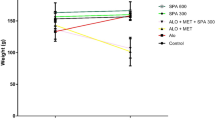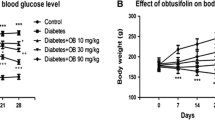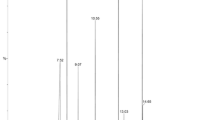Abstract
Plants with antidiabetic activities provide important sources for the development of new drugs in the treatment of diabetes mellitus. In the present study, we investigated possible antihyperglycemic and antioxidative activities of the aerial part of the Matricaria chamomilla L. ethanolic extract (MCE) in streptozotocin (STZ; 70 mg/kg, i.p.)-induced diabetic rats. The following groups were assigned; sham (did not receive any substance), STZ + distilled water (control), STZ + 5 mg/kg glibenclamide, STZ + 20 mg/kg MCE, STZ + 50 mg/kg MCE, STZ + 100 mg/kg MCE. Diabetic rats were treated for 14 days by gavage. Postprandial blood glucose levels, malondialdehyde, reduced glutathione (GSH), nitrate, nitrite, ascorbic acid, retinol, β-carotene, superoxide dismutase, and catalase levels were measured, and immunohistochemical studies were performed in all of the groups. The obtained data showed that STZ resulted in oxidative stress and affected the antioxidant status. Treatment with different doses of MCE significantly reduced postprandial hyperglycemia and oxidative stress, and augmented the antioxidant system. In histological investigations, MCE treatment protected the majority of the pancreatic islet cells, with respect to the control group. As a result, MCE exhibited significant antihyperglycemic effect and protected β-cells in STZ-diabetic rats, in a dose-dependent manner, and diminished the hyperglycemia-related oxidative stress.






Similar content being viewed by others
References
Nolte MS, Karam JH (2004) Pancreatic hormones and antidiabetic drugs. In: Katzung BG (ed) Basic and clinical pharmacology. McGraw Hill, Singapore, pp 693–715
Altan N, Sepici-Dinçel A, Koca C (2006) Diabetes mellitus and oxidative stress. Turk J Biochem 31:51–56
Robertson RP, Harmon JS (2006) Diabetes, glucose toxicity, and oxidative stress: a case of double jeopardy for the pancreatic islet beta cell. Free Radic Biol Med 41:177–184
Jay D, Hitomi H, Griendling KK (2006) Oxidative stress and diabetic cardiovascular complications. Free Radic Biol Med 40:183–192
Szkudelski T (2001) The mechanism of alloxan and streptozotocin action in B cells of the rat pancreas. Physiol Res 50:536–546
Baytop T (1984) Therapy with medicinal plants in Turkey (past and present). Publications of the Istanbul University, Istanbul, p 348
Mukherjee PK, Maiti K, Mukherjee K, Houghton PJ (2006) Leads from Indian medicinal plants with hypoglycemic potentials. J Ethnopharmacol 106:1–28
Andrade-Cetto A, Heinrich M (2005) Mexican plants with hypoglycaemic effect used in the treatment of diabetes. J Ethnopharmacol 99:325–348
Jain SK, McVie R, Duett J, Herbst JJ (1989) Erythrocyte membrane lipid peroxidase and glycolylated hemoglobin in diabetes. Diabetes 38:1539–1543
Beutler E, Duron O, Kelly BM (1963) Improved method for the determination of blood glutathione. J Lab Clin Med 61:882–888
Miranda KM, Espey MG, Wink DA (2001) A rapid, simple spectrophotometric method for simultaneous detection of nitrate and nitrite. Nitric Oxide 5:62–71
Omaye ST, Turnbul JD, Savberlich HE (1979) Ascorbic acid analysis. II. Determination after derivatisation with 2.2. dinitrophenylhidrazine. Selected methods for determination of ascorbic acid in animal cells tissues and fluids. In: McCormick DB, Wright LD (eds) Methods in enzymology, vol 62. Academic Press, New York, pp 7–8
Suzuki I, Katoh N (1990) A simple and cheap method for measuring serum vitamin A in cattle using spectrophototmeter. Jpn J Vet Sci 52:1281–1283
Aebi H (1984) Catalase in vitro. Methods Enzymol 105:121–126
Flohé L, Otting F (1984) Superoxide dismutase assays. Methods Enzymol 105:93–104
Armagan A, Uz E, Yilmaz HR, Soyupek S, Oksay T, Ozcelik N (2006) Effects of melatonin on lipid peroxidation and antioxidant enzymes in streptozotocin-induced diabetic rat testis. Asian J Androl 8:595–600
Hsu WT, Tsai LY, Lin SK, Hsiao JK, Chen BH (2006) Effects of diabetes duration and glycemic control on free radicals in children with type 1 diabetes mellitus. Ann Clin Lab Sci 36(2):174–178
Beltramini M, Zambenedetti P, Raso M, IbnlKayat MI, Zatta P (2006) The effect of Zn(II) and streptozotocin administration in the mouse brain. Brain Res 1109:207–218
Ramesh B, Pugalendi KV (2006) Antioxidant role of umbelliferone in STZ-diabetic rats. Life Sci 79:306–310
Aragno M, Mastrocola R, Catalano MG, Brignardello E, Danni O, Boccuzzi G (2004) Oxidative stress impairs skeletal muscle repair in diabetic rats. Diabetes 53(4):1082–1088
Sathishsekar D, Subramanian S (2005) Beneficial effects of Momordica charantia seeds in the treatment of STZ-induced diabetes in experimental rats. Biol Pharm Bull 28:978–983
Sugiura M, Ohshima M, Ogawa K, Yano M (2006) Chronic administration of satsuma mandarin fruit (Citrus unshiu MARC.) improves oxidative stress in streptozotocin-induced diabetic rat liver. Biol Pharm Bull 29:588–591
Jessup W, Mohr D, Gieseg SP, Dean RT, Stocker R (1992) The participation of nitric oxide in cell free- and its restriction of macrophage-mediated oxidation of low-density lipoprotein. Biochim Biophys Acta 1180:73–82
Hayashi K, Noguchi N, Niki E (1995) Action of nitric oxide as an antioxidant against oxidation of soybean phosphatidylcholine liposomal membranes. FEBS Lett 370:37–40
Mohamadin AM, Hammad LN, El-Bab MF, Gawad HS (2007) Can nitric oxide-generating compounds improve the oxidative stress response in experimentally diabetic rats? Clin Exp Pharmacol Physiol 34(7):586–593
Kabat A, Dhein S (2006) l-arginine supplementation prevents the development of endothelial dysfunction in hyperglycaemia. Pharmacology 76(4):185–191
Acknowledgments
This study was supported by a grant from the Afyon Kocatepe University research fund (06.FENED.07). The authors thank Prof. Dr. Abdullah Çağlar, Faculty of Food Engineering, Afyon Kocatepe University, for the helpful suggestions to this paper.
Author information
Authors and Affiliations
Corresponding author
Rights and permissions
About this article
Cite this article
Cemek, M., Kağa, S., Şimşek, N. et al. Antihyperglycemic and antioxidative potential of Matricaria chamomilla L. in streptozotocin-induced diabetic rats. J Nat Med 62, 284–293 (2008). https://doi.org/10.1007/s11418-008-0228-1
Received:
Accepted:
Published:
Issue Date:
DOI: https://doi.org/10.1007/s11418-008-0228-1




